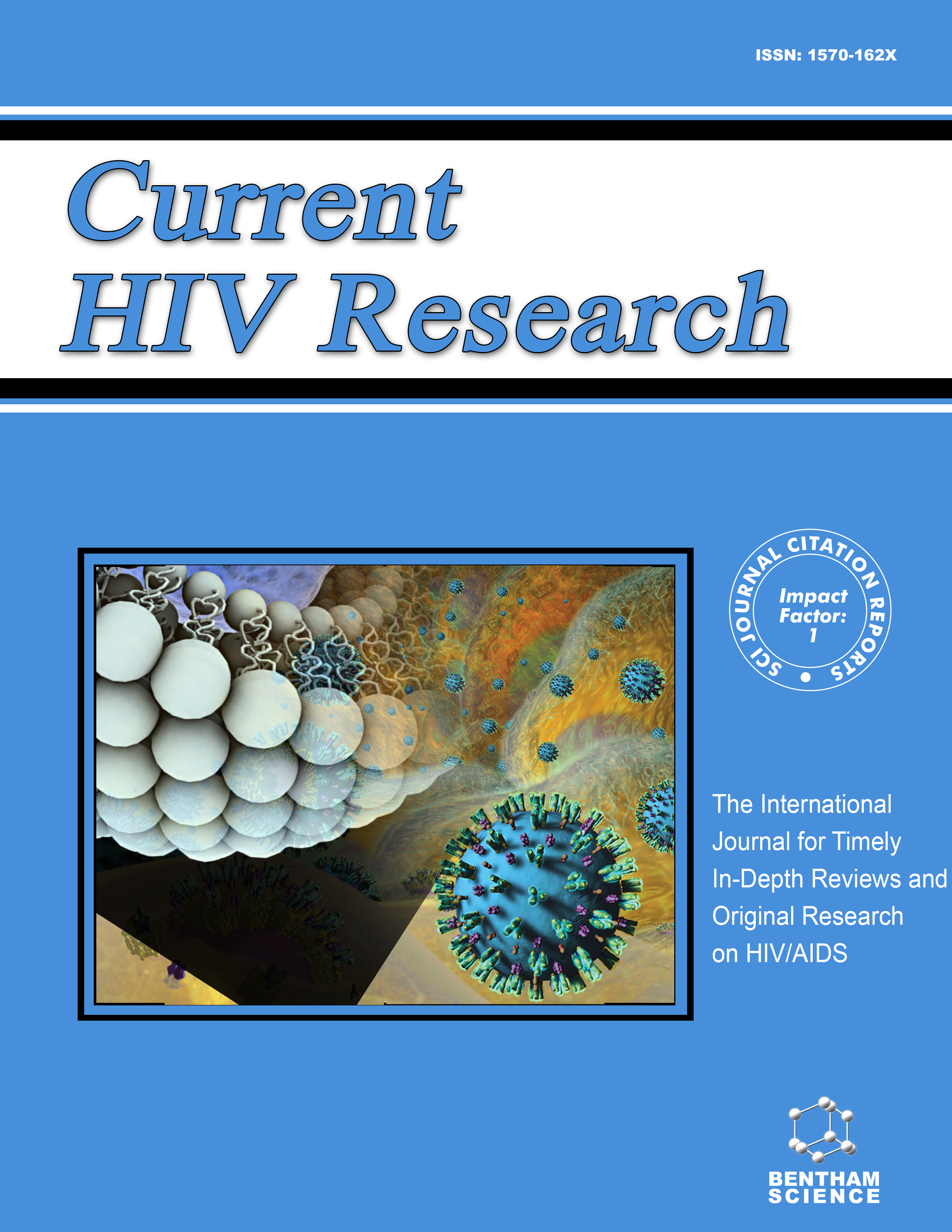- Home
- A-Z Publications
- Current HIV Research
- Previous Issues
- Volume 14, Issue 6, 2016
Current HIV Research - Volume 14, Issue 6, 2016
Volume 14, Issue 6, 2016
-
-
HIV Infection and Myocardial Infarction
More LessBackground: After the advent of the potent combination antiretroviral therapy (cART) the incidence of acquired immune deficiency syndrome (AIDS) has declined dramatically and HIV infection became a chronic disease with a significant increase in the life expectancy of HIV-positive people. Consequently, chronic comorbidities as coronary heart disease raised an increasing concern in this population. Objective: Aim of Read More
-
-
-
Spatiotemporal Analysis of AIDS Incidence Among Adults in Brazil
More LessAIDS is the fourth leading cause of death worldwide and, currently, the overall prevalence rate of HIV infection in Brazil is 0.5% among men and 0.3% among women. Objective: To evaluate the spatiotemporal trend of AIDS in Brazil from 2006 to 2012 and its relationship with human development index (HDI) and their components income, education and life expectancy. Methods: This ecological study evaluate the spati Read More
-
-
-
Design-Based Peptidomimetic Ligand Discovery to Target HIV TAR RNA Using Comparative Analysis of Different Docking Methods
More LessDiscovering molecules capable of binding to HIV trans-activation responsive region (TAR) RNA thereby disrupting its interaction with Tat protein is an attractive strategy for developing novel antiviral drugs. Computational docking is considered as a useful tool for predicting binding affinity and conducting virtual screening. Although great progress in predicting protein-ligand interactions has been achieved in the past few decade Read More
-
-
-
Reactivation of latent HIV-1 in latently infected cells by coumarin compounds: Hymecromone and ScoparoneReactivation of Latent HIV-1 in Latently Infected Cells by Coumarin Compounds: Hymecromone and Scoparone
More LessAuthors: Xian Li, Hanxian Zeng, Pengfei Wang, Lu Lin, Lin Liu, Pinyi Zhen, Yuanzhe Fu, Panpan Lu and Huanzhang ZhuBackground: Current antiretroviral therapy (ART) cannot cure HIV-1 infection due to the presence of latent viral reservoirs. The “shock and kill” strategy is a promising approach to eliminate the viral reservoir. However, there are various limits existing in current latency-reversing agents, searching for new activators are urgently needed. Objective: The present study aimed at investigating the ability of hymecromone and s Read More
-
-
-
Baseline CD4/CD8 T-Cell Ratio Predicts Prompt Immune Restoration Upon cART Initiation
More LessIntroduction: The reversal of CD4/CD8 ratio is considered an independent predictor of death in the general population, where the ratio physiologically decreases with aging. Despite effective cART, CD4/CD8 normalization does not always occur in HIV-positive subjects. In the setting of HIV, low CD4/CD8 T-cell ratio correlates with immune activation and non-AIDS events. The aim of the study was to evaluate the rate and Read More
-
-
-
Effects of Antiretroviral Molecules on Survival and Gene Expression of An Osteoblast-like Cell Line
More LessBackground: The advent of combined antiretroviral therapy effectively undermined the evolution of HIV disease. Nevertheless, clinical observations indicated a clear association between therapy and the impairment of bone mineral density. Objective: We selected some antiretroviral compounds used in clinical practice, to study their impact on bone health and their possible implication in the onset of bone disease. Method: Scalar Read More
-
-
-
Naringin Ameliorates HIV-1 Nucleoside Reverse Transcriptase Inhibitors- Induced Mitochondrial Toxicity
More LessAuthors: Adebiyi Oluwafeyisetan, Adebiyi Olubunmi and Owira PeterBackground: Mitochondrial reactive oxygen species (ROS) generation and defective oxidative phosphorylation (OXPHOS) have been proposed as possible mechanisms underlying the development of nucleoside reverse transcriptase inhibitors (NRTIs)-induced mitochondrial toxicities. Available options in managing these complications have, so far, produced controversial results, thus necessitating further research into newer ag Read More
-
-
-
Prevalence of HIV-1 Subtypes and Antiretroviral Drug Resistance Mutations in Nepal
More LessBackground: There have been very few reports of HIV-1 subtypes and drug resistance mutations (DRMs) from Nepal which is geographically located between two high-prevalence HIV-1 infection countries, China and India. Objective: The aim of this study was to determine prevalence of acquired and transmitted DRMs and HIV-1 subtypes in Nepal. Methods: Thirty-five HIV-1 seropositive samples from central region of Nepal were c Read More
-
Volumes & issues
-
Volume 23 (2025)
-
Volume 22 (2024)
-
Volume 21 (2023)
-
Volume 20 (2022)
-
Volume 19 (2021)
-
Volume 18 (2020)
-
Volume 17 (2019)
-
Volume 16 (2018)
-
Volume 15 (2017)
-
Volume 14 (2016)
-
Volume 13 (2015)
-
Volume 12 (2014)
-
Volume 11 (2013)
-
Volume 10 (2012)
-
Volume 9 (2011)
-
Volume 8 (2010)
-
Volume 7 (2009)
-
Volume 6 (2008)
-
Volume 5 (2007)
-
Volume 4 (2006)
-
Volume 3 (2005)
-
Volume 2 (2004)
-
Volume 1 (2003)
Most Read This Month
Article
content/journals/chr
Journal
10
5
false
en


